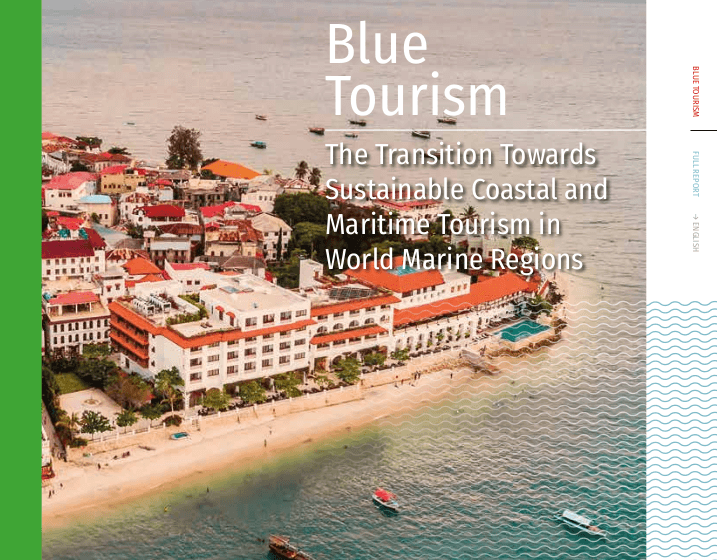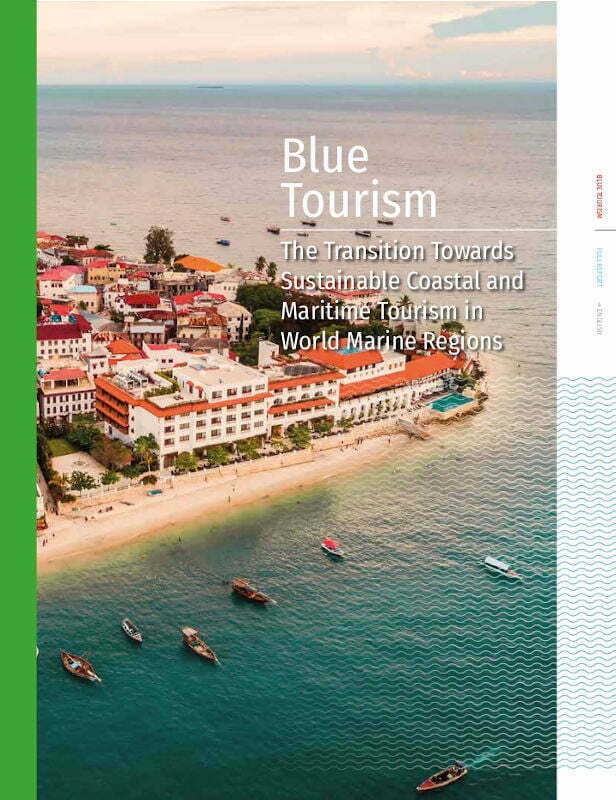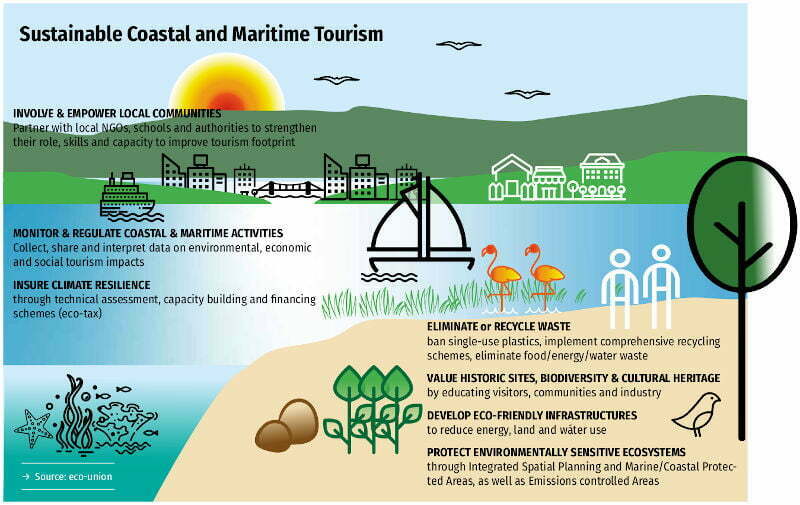A new report states that coastal and maritime tourism (CMT) has become a major economic sector for countries with accessible and attractive coastlines. However cruises, resorts and even ecotourism are Blue Tourism activities with critical environmental and social impacts on natural resources and local communities.

In addition, oceans and littorals are increasingly coveted spaces as strategic resources for states and businesses as they sustain a large part of the world population and global economy.
Hence, coastal and maritime tourism, as part of the Blue Tourism, is facing emerging challenges at local and global level that deserve closer attention. In particular, the interlinkage of tourism with sustainability commitment such as the Paris Agreement.
In this context, this report intends to understand and define better the ecological impacts of coastal and marine tourism in the Mediterranean, the Caribbean, the North East Atlantic, the South Pacific Ocean, and the Western Indian Ocean, the major global marine regions, in order to disseminate field learnings and develop common policy recommendations for policy-makers, tourism stakeholders and other relevant institutional and civil society actors.
Download – Blue Tourism
Global coastal and marine challenges
- Tourism is a major economic sector for developing countries, accounting for up to 25 % of national GDPs in Small Islands Developing States (SIDS), with high visitor concentration in space and time, mainly in the coastlines.
- More than 600 million people (around 10% of the world’s population) live in coastal areas that are less than 10 meters above sea level and nearly 2.4 billion people (about 40% of the world’s population) live within 100 km (60 miles) of the coast, hence depending and vulnerable to ocean’s quality, stability and accessibility.
- Climate change will affect strongly the coastal areas with high anthropic vulnerability, through temperature increase, more frequent environmental events, water scarcity and sea level rise (SLR).
Blue Tourism is highly dependent on the quality of natural ecosystems to attract visitors but at the same time is strongly contributing to its depletion and fragilization, hence putting at risk its own sustainability.
Specific coastal and marine tourism issues
- Cruising: a major source of large environmental and social impacts, which are not addressed by current legislations and governance schemes.
- Hotels and Resorts: a mass-tourism offer with popular and affordable products for local and global travelers, generating unbalanced environmental, social and economic effects.
- Ecotourism: an emerging alternative to mass tourism, with reduced negative environmental externalities and higher benefits for local communities.

Blue Tourism Recommendations
By analysing existing practices and institutional frameworks in the world marine regions, key levers for a sustainable tourism industry have been identified, with recommendations for governments, public and private actors, focused on preventing and mitigating spatial, social and environmental impacts of coastal and maritime tourism around the marine regions as part of the Blue Tourism.
It covers governance mechanisms, environmental regulations and management issues, as well as promoting initiatives limited not only to alternative tourism and niche market segments, but also covering the entire mass-tourism sector including cruise and resorts.
1. Global Actions for Sustainable Coastal and Maritime Tourism
Sustainable coastal and maritime tourism policies must acknowledge the impacts of tourism activities on the coastal territories, the vulnerability and complexity of the coastal and maritime ecosystems and its interactions with
the different sub-components of the CMT.
1.1. Promotion of policy coherence, stakeholders collaboration and cooperation mechanisms in order to ensure coherent, integrated and consistent policies at all political, geographic and sectoral level,
1.2. Support of integrated maritime & coastal planning through an ecosystem-based approach by implementing transversal spatial and environmental planning instruments,
1.3. Development of comprehensive monitoring, evaluation and statistics schemes by measuring and monitoring the impacts of maritime and coastal tourism to natural ecosystems, promoting quantitative instruments and assessment tools to evaluate the carrying capacity of destinations or territories,
1.4. Identification, support and dissemination of sustainable practices, responsible businesses and green skills, by promoting sustainable business practices,
1.5. Implementation of sectoral strategies and action plans to green and decarbonize the whole tourism industry,
1.6. Financing sustainable blue tourism activities, strategies and actors in order to guarantee the alignment of development aid and cooperation schemes,
1.7. Involvement, Involvement and empowerment and empowerment of travellers, the industry and key stakeholders, by partnering with the private sector, educating travellers and tourists, and engaging with civil society.
2. Specific Recommendations for Hotels and Resorts
2.1. Mainstreaming of sustainability certifications, eco-labelling and environmental initiatives through the identification, adaptation and implementation of a shared and standardized certification system for hotels and resorts at the regional and national levels,
2.2. Implementation of sustainable and comprehensive tourism planning, monitoring and management tools by developing regional and national policies to redistribute tourism on a spatial and temporal scale,
2.3. Increase investments in energy efficiency, water treatment and waste recycling schemes, by promoting industry management plans of natural resources for the use of energy, water and food in hotels and resorts.
3. Specific Recommendations for Cruises and Ports
3.1. Providing sound regulation, technical support and financial incentives to green ports and cruises practices by developing green tax schemes in ports and cruises, supporting investment for onshore Power Supply
(OPS), and implementing stringent environmental legislation controlling air pollution such as Emissions Control Areas.
3.2. Leverage zoning, integrated planning and risk mitigation in sensitive marine areas by reducing and monitoring cruise traffic in or near Marine Protected Areas, and identifying, regulating and enforcing Particularly
Sensitive Sea Areas.
3.3. Monitor, manage and regulate passengers and cruise flows, by redistributing cruises disembarkation away from the city centres and dense areas, and developing a comprehensive database and planning of passengers and cruise flows.
3.4. Promotion of environmental conception, construction, operation and dismantling of cruise vessels, by implementing eco-design tools such as Life Cycle Assessment, and investing in resources-efficient technologies and environmental practices.
4. Specific Recommendations for Ecotourism
4.1 Development of integrated monitoring & planning, ecotourism strategies and networking platforms, by putting in place integrated monitoring and planning tools, and designing medium and long-term ecotourism development strategies, and creating national and regional networks of ecotourism destinations.
4.2. Maximisation of economic and social benefits for and by local communities, by supporting community-based businesses, developing strategic economic sectors of the local community, and reinvesting generated revenues by ecotourism activities.
4.3. Dissemination of sustainable practices and environmental initiatives through enhancement of sustainability certifications and eco-labels, education, preparation and empowerment of eco-tourism staff, visitors and local population.
4.4. Monitoring of ecotourism through data collection and participatory science by developing and implementing integrated indicators, and promoting scientific research on local ecosystems.
Blue Tourism – Sustainable Coastal and Maritime Tourism

The emerging destinations are becoming quickly emergency territories due to its rising vulnerability to environmental risks, climate change impacts, biodiversity losses and quality of ecosystems, putting in danger coastal territories and local communities and requesting urgent policy answers.
It is also necessary to take into account the long-term trends in tourism production and consumption patterns to anticipate – and influence – growth scenarios and increase resilience to natural, social and economic shocks for local communities and socio-economic structures.
Finally, the development of monitoring tools and multi-stakeholders governance mechanisms, both globally and locally, is strongly needed to allow a full overview and comprehensive management of the reality of maritime and coastal tourism.
The use of participatory tools such as citizen science are therefore very useful to collect data at a very low cost while involving local communities
and educate visitors and industry value chain.
- Promotor, developer and coordinator: eco-union
- Strategic support: IDDRI- Institute for Sustainable Development
and International Relations - Funder : ADEME Agence de l’Environnement et de la Maîtrise de l’Énergie
Blue Tourism Citation
Tonazzini, D., Fosse, J., Morales, E., González, A., Klarwein,
S., Moukaddem, K., Louveau, O. (2019) Blue Tourism – Towards a sustainable coastal and maritime tourism in world marine regions. Edited by eco-union. Barcelona.

